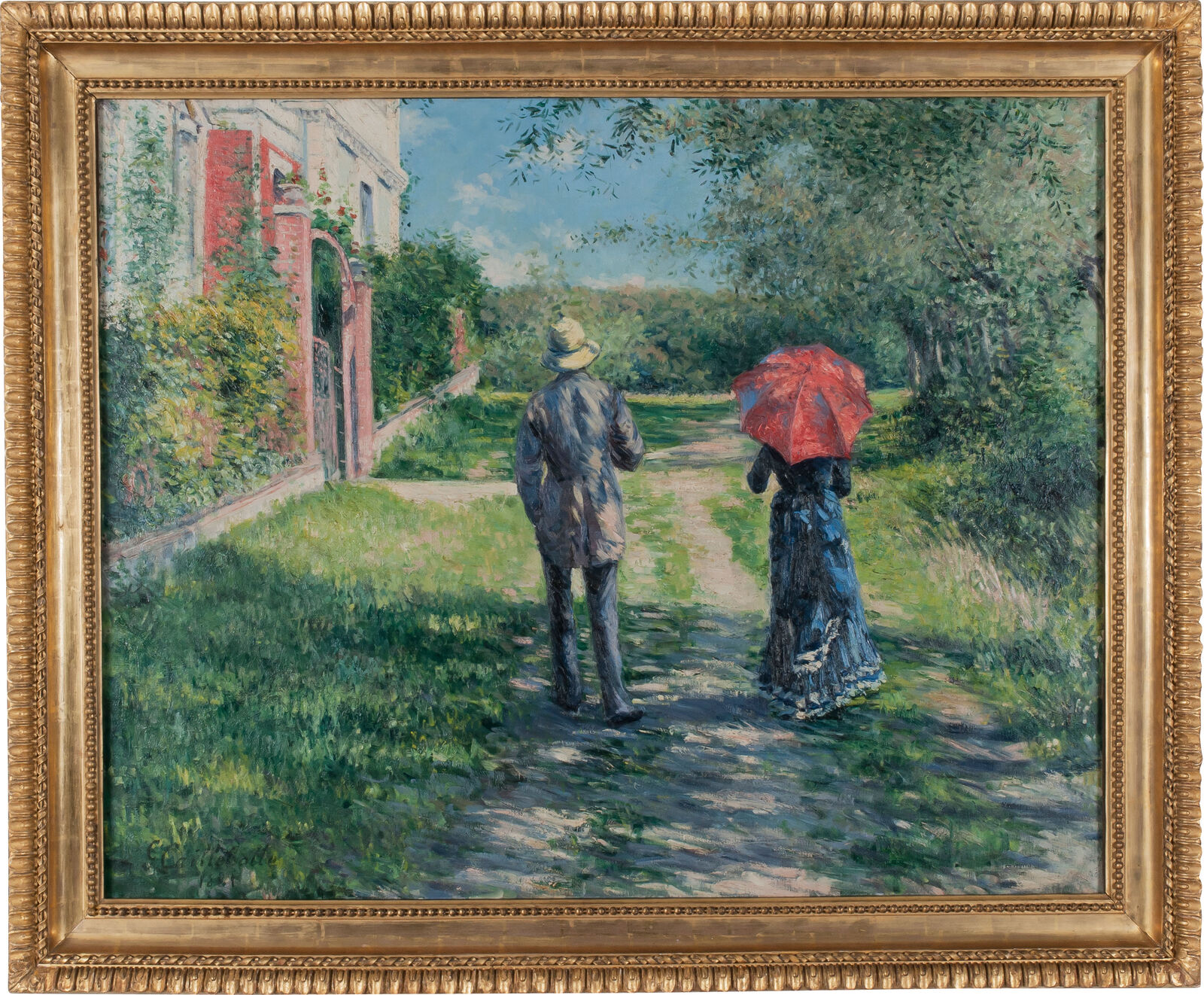Gustave Caillebotte
Couple on a Walk, 1881
On view
7 further works by Caillebotte
Copy link
Oil on canvas, 100,2 x 125,3 cm
Signed and dated lower left: G Caillebotte 1881
Inv.-no. MB-Cai-03
In the 1860s the seaside resorts in Normandy became the most popular summer retreats of the Parisian bourgeoisie. Here a young couple (likely the artist and his partner, Charlotte Berthier) are strolling past the luxurious Villa italiennein Trouville. The red parasol adds an accent to the picture, in which fresh green tones are dominant. The depiction of the figures from behind allows viewers to put themselves in the role of the vacationers.
Every summer from 1880 to 1884, Gustave Caillebotte spent a number of weeks in Normandy, where he sailed in regattas and painted. During this time he produced around fifty depictions of the area surrounding Trouville, a beach resort that had grown into a favorite holiday destination of the Parisian upper classes since the mid-nineteenth century. While his older colleagues Eugène Boudin and Claude Monet had focused on the beach promenade in their scenes from Trouville, Caillebotte was more interested in the inland landscape. Couple on a Walk was executed in 1881 and shows two fashionably dressed strollers viewed from the rear. The composition represents a transitional work between Caillebotte’s city views of Paris from the 1870s and the landscapes he would paint after moving to the Seine village of Le Petit-Gennevilliers in 1881.
The strong recession in depth established by the diagonal line of the villa on the left and the triangular composition of the sun-dappled path echoes the dynamic visual axes Caillebotte had already developed in his city scenes. The unusual perspective in which the path seems almost folded upward had likewise emerged as a trademark feature of his work by the early 1880s. With its loose brushwork and ephemeral quality, the picture shows a stronger stylistic connection to the landscapes of Monet, Pierre-Auguste Renoir, and Alfred Sisley, works that would prove decisive for the evolution of Caillebotte’s career. The soft reddish tones of the Italian villa and the fashionable scarlet parasol to the right set powerful accents in a composition that is otherwise dominated by fresh hues of green.
The identity of the couple strolling together at a respectable distance from each other is unclear. The young man, who wears typical rowing clothes with a straw hat, could be Caillebotte himself or his brother Martial, with whom he usually spent the summer holidays near Trouville. The woman could be Caillebotte’s longtime companion Charlotte Berthier. The view from the rear and the ambiguous relationship between the two protagonists lend the composition a psychological tension that also characterizes many of Caillebotte’s interiors. When he showed the painting in the Seventh Impressionist Exhibition in Paris in 1882, it attracted considerable attention for its free painterly style and substantial size.
In the catalogue raisonné of Caillebotte’s paintings compiled by Marie Berhaut, Couple on a Walk is listed as no. 158.
Daniel Zamani
7me Exposition des Artistes Indépendants, Salons du Panorama de Reichshoffen, Paris, (probably March 1–31) 1882, no. 3
Gustave Caillebotte: Urban Impressionist, Galeries Nationales du Grand Palais, Paris, September 12, 1994–January 9, 1995; The Art Institute of Chicago, February 15–May 28, 1995, no. 89 (Paris), 98 (Chicago)
Impressionism: The Hasso Plattner Collection, Museum Barberini, Potsdam, from September 5, 2020
1930, Jeanne Schultz, Paris
n.d., Private collection, France, inherited from the above
November 4, 2003, Christie’s, New York, lot 15, consigned by the above
Private collection, London, acquired at the above sale
February 27, 2019, Christie’s, London, lot 28, consigned by the above
R.J. Draner, “Une visite aux impressionnistes,” in Le Charivari (March 9, 1882), ill. unpaginated (Sketch illustrated)
V.G. Fichtre, “L'actualité. L'exposition des peintres indépendants,” in Le Réveil (March 2, 1882)
H. Robert, “Chronique parisienne: Le Salon des impressionnistes,” in La Petite Presse (March 5, 1882), p. 1
J. de Biez, Les petits salons: Les indépendants (March 8, 1882)
Paul de Charry, “Beaux-Arts,” in Le Pays (March 10, 1882)
Marie Berhaut, Gustave Caillebotte: Catalogue raisonné des peintures et pastels, Paris 1994, no. 158, ill. p. 136
Ruth Berson, The New Painting: Impressionism 1874–1886. Documentation, vol. 2, San Francisco/Seattle 1996, no. VII-3, p. 201
Gustave Caillebotte: The Unknown Impressionist, exh. cat. Royal Academy of Arts, London 1996, ill. p. 164
Jacques-Sylvain Klein, Lumières normandes: Les hauts lieux de l'Impressionisme, Rouen 2013, ill. p. 194 (La rue montante)
Michael Marrinan, Gustave Caillebotte: Painting the Paris of Naturalism, 1872–1887, Los Angeles 2016, p. 327–29, ill. p. 327
Impressionism: The Hasso Plattner Collection, exh. cat. Museum Barberini, Potsdam 2020, p. 47, 149, 264, ill. p. 46, 264
Video
Barberini Audioguides
Do you have suggestions or questions?
sammlung@museum-barberini.de.

